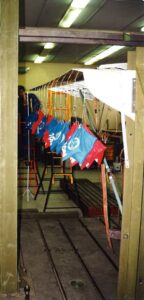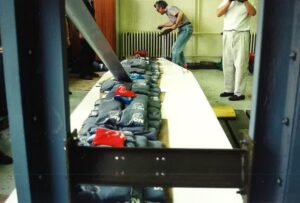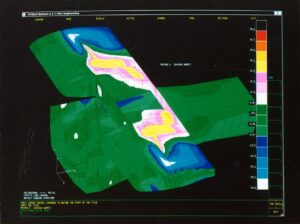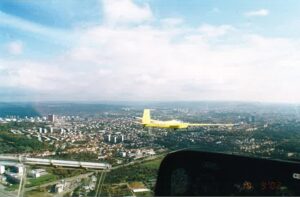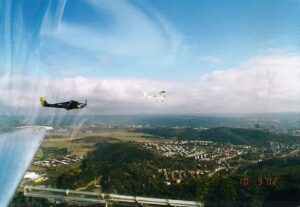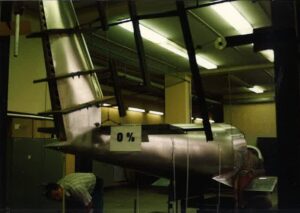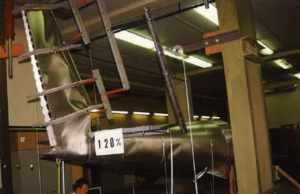Pre-war history
Brno’s technical university was established as part of the German technical school which was founded in 1849. It became an independent Czech university 50 years later. It was one of the very progressive technical universities in Europe. That is why it could not remain indifferent to such a promising and significant technical field as aeronautics. The beginning of teaching aviation at the Brno technical university, which was then officially called Dr. Edvard Beneš Technical University, goes back to 1937, when the study of aeronautics was incorporated into the field of motor transport. In that year, it was doc. Ing. V. Hacura who was assigned the task of teaching the encyclopedia of aircraft design. The school already owned a wind tunnel thanks to MNO. It should be noted that a similar long-time effort to start teaching aviation at the Prague technical school was achieved as early as 1929 by introducing specialized aviation courses. These one-year courses were designed for graduates in mechanical engineering. It was in fact a postgraduate study programme. The effort made by both of the universities to build up Czechoslovakian higher education in aeronautics was violently discontinued by the German Reich protectors closing Czech universities in 1939.
Post-war history
Immediately after the liberation in 1945 the Brno technical university resumed its activities. Great enthusiasm is shown when proper aviation teaching is being prepared. With an active support of the rector of the Brno University of Technology, prof. J. Kožoušek, four institutes of aerospace engineering were established between 1945 and 1948. Professors F. Sekanina, J. Špunda, F. Pospíšil, and V. Smolař became their heads. The first two mentioned already worked at the university before the war from 1938. In the academic year of 1948/49, the study plan for the group of motor vehicles and aviation in mechanical engineering already included a wide enough range of aviation disciplines such as aircraft aerodynamics (prof. Smolař), technology, glider design, the study of aircraft materials (prof. Sekanina), aircraft static stability, propeller design (prof. Špunda), aircraft design (pro. Pospíšil), special aircraft (ing.dr. Brůha). Other subjects included aircraft equipment, testing, engines, meteorology, navigation, air traffic and others. There were a total of 25 hours of lectures and 11 hours of seminars a week.
The 1950s and the changes caused by the events of 1948
The promisingly developing intellectual aviation base at the Brno technical university was affected by an unexpected metamorphosis in 1951 – an unwelcomed and violent transformation of the civilian technical school into a Military Technical Academy. The civilian technical university in Brno seized to exist. All its facilities and equipment were swallowed by the MTA in the name of a higher interest. Some other institutions including the Masaryk University lost some of their buildings as well. The teachers who did not leave to teach at other universities had to start wearing uniforms. The same happened to the students as well. So there were former professors of the civilian technical university, now professors of MTA, walking in the streets of Brno wearing military uniforms, mostly colonels, who returned greetings by lifting their peaked caps. Others showed their smart civilian waistcoats with the necessary decorative pocket watch chains under their unbuttoned uniforms. This was disapproved of by the commanding officials, who allowed some professors to become civilian teachers at the Military academy again. These are of course insignificant consequences, suitable only for amusement. A more serious situation arose soon after. The assumption and obligation saying that the MTA will also bring up engineers in all the fields for civilian needs could not and was not fulfilled by this school. The MTA only fulfilled its obligations in bringing up university experts in the fields immediately related to the special military and arms industry. Aviation had been one of them since the foundation of the MTA. When the MTA was established in 1951, teaching aviation was cancelled at the Czech University of Technology in Prague. The MTA therefore became a monopoly in bringing up engineers for the aviation industry. No wonder then that almost all the current middle and older generations of university graduates working in our aviation industry including private aerospace companies are the graduates of the Faculty of Aviation of the Military Academy in Brno.
The unsustainable situation in bringing up engineers for other branches of civilian industry soon asked for a solution. The industrially strong Moravian part of the republic soon felt the desperate shortage of engineers. Practical needs necessitated the reestablishment of a civilian technical school in Brno. In a very difficult situation, thanks to a very active and selfless commitment of former professors of the technical university and with the indulgent help of the MTA, the Brno civilian technical school was re-established in 1956 under a new name of the University of Technology. Unfortunately, aviation teaching was not part of the re-established school. The MTA kept its monopoly. The upbringing of aerospace experts in military-industrial branches at the Antonín Zápotocký Military Academy finished in 1970. In the following years the Military Academy only continued in irregular teaching of corporate scholarship holders who came to study aerospace engineering towards the end of their studies at other universities depending on the specific needs of the aerospace industry.
The 1980s and the reestablishment of civilian aviation teaching
Cancelling the regular upbringing of aerospace engineers at the Antonín Zápotocký Military Academy soon resulted in the establishment of the Aircraft Department at the Faculty of Mechanical Engineering of the Czech University of Technology in Prague and the beginning of teaching aircraft design, aircraft engines and aircraft production. Therefore, there are its first graduates as early as 1976.
The same was achieved at the Brno University of Technology with a historically insignificant delay. The regulation of the Ministry of Education of ČSR from January 31st 1982 approved the teaching of „aircraft equipment“ at the faculty of Mechanical Engineering of the BUT. The Aircraft Department at the FME BUT was re-established by the rector’s decree (Prof. Ing. František Kouřil, DrSc.) on April 1st 1982. Doc. Ing. Světmír Látal, CSc. was nominated for the position of the head of the renewed Aircraft Department as he was suitable in terms of expertise (he had taught flow, thermo-mechanics, and aircraft engines at the Military Academy) and also in terms of sufficient experience in managing positions (he had been the Deputy Commander at the Faculty of Aviation of the MA for several years). However, Mr. Látal suddenly and unexpectedly died in the summer of 1982 and it was Doc. Ing. Karol Filakovský, CSc. who was appointed the new head of the renewed Aircraft Department. In the first years, from September 1982 to the summer of 1987, the department was located in the FME campus in Úvoz street. Besides the above mentioned head of the department, other members included Ing. Vladimír Daněk, CSc., Mrs. Libuše Daňková, the secretary and Mr. Josef Streit, the head of the department laboratories and the only person to work in them. Teaching started in the following academic year of 1983/84. The first graduates in the renewed field of Aircraft Equipment graduated in June 1985 in the number of ten.
Adequately to the needs of the aerospace industry in Moravia, aerospace engineers were brought up in the fields of aircraft design and aircraft production technology in a five-year master’s study programme. The reestablishment of teaching aviation at the civilian technical school was not any easier than its initial foundation. And as is well known, every beginning is difficult. The difficulties especially lied in insufficient material equipment. While the original equipment of the civilian machinery at aerospace departments is still being used by the MA, there is a different situation as for the “human inventory”, which is no longer part of the MA. Many a qualified lecturer who had to leave the MA as a result of so called Husák’s normalization proved at the BUT that they hadn’t forgotten their “craft” and significantly contributed to the fact that from the very beginning the aviation classes were of a high standard. It’s a pity that most of these lecturers belong now to the elderly teachers of their branch. Knowing their historical part, they have passed their valuable experience on to their younger successors. Partial rectification of the past wrongs that were committed in the 1950s in the spirit of Stalin’s megalomania and militant ideology of the communist regime was achieved only after the Velvet Revolution in 1989 when thanks to the students’ activities supported by the citizens of Brno, the BUT and the Masaryk University were given back their historical facilities. In the meantime, after some rigmarole concerning BUT facilities, building of the new Mechanical Engineering campus was started, in which the Aircraft department is situated. The historical facilities in which the former aircraft departments were located belong now to other BUT faculties.
Development after the Velvet Revolution
Thanks to a determined effort of the Aircraft Department small team and cooperation with external teachers, this branch gained its place among other branches at the faculty of Mechanical Engineering. It belongs to attractive and challenging scientific and technical branches that only a few European technical universities can be proud of. Several changes and innovations concerning subjects and contents of traditional aviation disciplines were made in the post-revolutionary teaching of this branch. The main focus is on the general civil aviation, particularly sport and small utility aircraft. The modernization of the teaching process is in computerizing and computer support of the engineers’ work starting with aircraft design, calculations and ending with the construction and technological preparation of the production.
Since the laboratory equipment is still insufficient, there are many excursions to several aviation companies where students can gain professional experience. One of the most popular practical classes is in-flight testing. Knowing the truth of the popular saying „better to see it once than hear it ten times“, the aircraft department bought a motor glider L-13SW „Vivat“ (next picture) in 1985, which was contracted in the Brno-Medlánky Aero club. Our students were able to embrace the secrets of an atmospheric flight and carry out simple measurements that were originally done in the town of Kunovice on the L-410 airplane at significantly higher operating costs.
In the revolutionary year of 1989, when seven years had passed since the foundation of the aircraft department, more liberal academic conditions began for the next development of the department. The Iron Curtain had fallen. We opened ourselves to the world and the world opened to us. A new era begins which is more suitable for a wider international collaboration whose absence during socialism drew us almost amongst developing countries. With a certain feeling of sadness thinking where we could have been if it hadn’t been for the wrong political choice about fifty years ago, we now accept help from the European Union. One of the significant international activities in which the Aircraft Department together with the Czech University of Technology in Prague (ČVUT) participate is the TEMPUS programme. Being part of this organized student and teacher exchange programme we had an excellent opportunity to learn, acquire and exchange our experience with renowned European technical universities. The first such international project was TEMPUS, which was coordinated by the Glasgow University. Due to this activity, ten of our students of the aviation equipment branch could study for six months at universities in Germany, Great Britain and The Netherlands. The students who were not picked and couldn’t go didn’t get the raw deal. They could attend lectures during these exchange programmes given by several professors from the above mentioned universities and also universities from France, Italy and Spain. The students can at least realize that all over the world education is considered an important life investment which sooner or later pays off. This fact is already being reflected at our students’ study morale and their results.
Foundation of the Institute of Aerospace Engineering
In 1993 the Faculty of Mechanical Engineering transformed the existing departments into higher pedagogical and science units – institutes. The Institute of Aerospace Engineering was founded on 1st May 1993 and prof. Ing. Antonín Píštěk, CSc., who had so far been the head of the Aircraft Department, was appointed the first director of the institute. A field expert who is able to create a link between the theory and practice. Working for the aviation industry brings the first results. A range of aircraft and ultra-light aircraft project studies proves it. Let’s point out that a certain number of these works came to existence during these exchange programmes of our students and teachers at foreign universities. These stays are nowadays a common feature of the study at the Institute of Aerospace Engineering. Almost every student can participate in these international exchange programmes and study at some of the European universities. The paths that the Institute of Aerospace Engineering wants to take as for the aircraft equipment branch are: modern computational methods for complex strength and dynamic assessment of the aircraft structures including aero-elasticity. Another field of interest would be flight aerodynamics and mechanics focusing on improving computational models for aircraft design. The Institute of Aerospace Engineering is well equipped with computers and cutting edge programmes. Among other important fields are composite materials, aircraft dependability system assessment, or component hydraulic parameter assessment. The research endeavours of the Institute of Aerospace Engineering increased after building the aircraft testing room which is mainly used for strength and dynamic assessments of small aircraft and parts thereof. This university institute will, alongside teaching and research tasks, continue to carry out tasks for the Czech state and private aviation industry, particularly in the Moravian region. The amateur designers are not left out as they can use the testing room for carrying out the required strength tests of their aircraft. Concentrating all the research, development and teaching under one roof naturally reflects in improving the training of our graduates for their future career. Several photographs of the original testing room can be found here, here and here.
Taking into consideration that the year of 1993 was also the year when the Czech Federation split apart, the Institute of Aerospace Engineering extended its branches and a new branch of Air Traffic was included in the Master’s study programme. So, in 1995 first graduates leave the university with this specialization which was until 1993 taught solely at the University of Traffic and Communication in Žilina. We still collaborate with this university, today University of Žilina. The Institute of Aerospace Engineering also has a certificate which entitles us to offer a theoretical training for professional pilots as part of a three-year Bachelor’s study programme in accordance with the European standards.
